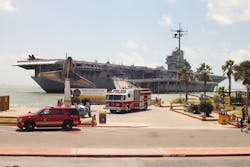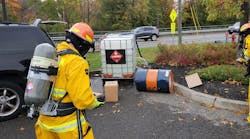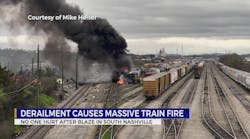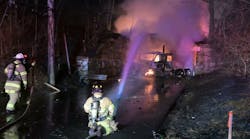Corpus Christi is located in south Texas on the Gulf of Mexico. Corpus Christi in Latin means “Body of Christ.” The name was given to the settlement and surrounding bay by Spanish explorer Alonso Alvarez de Pineda in 1519, as he discovered the lush semi-tropical bay on the Catholic feast day of Corpus Christi. The city has been nicknamed “Texas Riviera” and “Sparkling City by the Sea.”
The estimated population of Corpus Christi today is in excess of 325,000. Corpus Christi has a total area of 460.2 square miles of which 154.6 square miles is land and 305.6 square miles is covered by water. Corpus Christi is home to the 6th largest port in the United States. The Port of Corpus Christi was opened in 1926, and the Corpus Christi Naval Air Station was commissioned in 1941. The city has a humid subtropical climate, with hot summers and very short, mild winters.
Fire department basics
Citizens of Corpus Christi organized their first fire company on Nov. 28, 1871, with a meeting to elect officers following the arrival of their new engine. Felix Noessel was elected foreman of the Pioneer Fire Company No. 1. On March 10, 1873, the second fire company in Corpus Christi was formed, the Lone Star Hook and Ladder Co. And on July 11, 1874, the Pioneer and Lone Star fire companies joined together to form the Corpus Christi Fire Department.
Today's modern Corpus Christi Fire Department is led by Chief Robert Rocha, former senior deputy fire chief for the Kansas City, KS, Fire Department. The Corpus Christi Fire Department operates from 17 fire stations covering an area of 170 square miles. Personnel include 414 firefighters who work 24/48 shifts, 30 administrative workers and seven civilians. The department has an operating budget of more than $47 million and an ISO rating of 2.
The department responded to 47,653 calls in 2014, 37,000 of which were EMS calls. Front-line apparatus include 16 engines, two towers, three trucks, one heavy rescue, six vehicle extrication units and 11 medic units. Specialty apparatus include five brush units; a command vehicle; "Big Bertha," a 3,000-gpm monitor; a hazmat vehicle; a light and air unit; and a fire boat. Every front-line apparatus is staffed with a captain, driver and, ideally, two firefighters.
Hazmat origins
Hazardous materials response in Corpus Christi began in July 1987, in response to the passage of Sara Title III following the deadly release of methyl isocyanate (MIC) in Bhopal, India, in 1984. As background, in 1980, the U.S. enacted the Comprehensive Environmental Response, Compensation, and Liability Act (CERCLA, aka Superfund) to facilitate the cleaning-up of sites contaminated by hazardous chemicals. In 1986, the U.S. made significant changes and additions to Superfund with the passage of the Superfund Amendments and Reauthorization Act (SARA). SARA Title III sets requirements for local and state emergency planning around hazardous chemicals, the right of the public to access information on chemical hazards in their community, and the reporting responsibilities for facilities that use, store and/or release hazardous chemicals.
The hazmat team was originally located at Station 9 and used an old ambulance as a response vehicle. Twenty personnel were sent to Texas A&M for training. In 1990, they converted a Lone Star beer truck to their response vehicle and equipped it with a computer and CAMEO software. Stations 3 and 5 were added to hazmat in 1993 and 1998, respectively.
Currently, Station 12 houses the Hazmat Unit, and Station 5 is the Hazmat/Decontamination Station. The department responds to hazmat calls with Engine 5 and a pickup pulling the decontamination trailer. Station 3 is also still designated as a Hazmat Station. The Hazmat Response Vehicle (Hazmat 12) is a 2001 E-One with a midship engine purchased with funds donated from a local refinery. Hazmat 12 is not a dedicated unit. Personnel from Station 12 staff the unit when a hazmat call comes in.
Current response levels
Corpus Christi Hazmat responds to around 100 calls each year. This does not include fuel spills, gas odors and leaks. Engine companies—which carry absorbent, Plug & Dike paste and a "football" plugging device—respond to fuel leaks, and the officer-in-charge makes a judgment call as to when the spill is beyond their control. Two engines and a chief are dispatched on the initial alarm, and one of the engines dispatched must have a four-gas meter. Specialized pickup trucks with additional absorbent can be dispatched for assistance. Hazmat 12 is called if the response is beyond the engine’s capabilities.
Mutual aid for hazmat is available from the Naval Air Station Corpus Christi’s Hazmat Team. Support help is also available from the Annaville Volunteer Fire Department. The next level of mutual aid comes from either San Antonio or Houston, about a two- and three-hour response time, respectively. When mutual aid is required for a refinery fire, Corpus Christi contacts the Refinery Terminal Fire Company (RTFC), a private company specializing in fire protection for the refineries.
Equipment carried on Hazmat 12 is typical of other departments. Breathing protection is provided by Scott AV-3000 SCBA with one-hour bottles. They also use cartridge respirators and powered air-purifying respirators (PAPRs). The light and air unit is utilized for refilling bottles. Chemical suit protection is provided by DuPont Level A Tychem Reflector garments and Level B Tychem SL; Chemrel BRs (BRs are medical suits provided for infection control for things like MRSA); DuPont Tyvek Saranex; and Lakeland LV94s. Scott Radiocom IIs are used for in-suit communications. Monitoring instruments include Gas-ID, Haz-ID, SE International RAD-60, Ludlum radiation meter, Drager Tubes, Ahura FirstDefender, and RAE Systems’ MultiRAE Plus, RAELink 3, MultiRAE and and RAELink 3 Mesh.
Eight other stations are equipped with four-gas and photoionization detector (PID) monitoring instruments as well. Terrorist agent monitoring instruments cover radiological and biological agents. The Corpus Christi Health Department has a gas chromatograph. Station 12 has a monitoring instrument shop where maintenance and repairs are made on monitoring instruments by hazmat team personnel.
Hazmat 12 also carries a variety of reference materials, including Internet access; three computers with CAMEO, ALOHA, MARPLOT and WISER software; and reference books, such as ERG 2012; Jane’s CBRN Response Handbook (4th edition); ACGIH TLVs and BEIs; Quick Selection Guide to Chemical Protective Clothing (6th edition); NIOSH Pocket Guide to Chemical Hazards; and the Association of American Railroads Field Guide to Tank Cars.
There are 48 firefighters and two chief officers trained to the technician level on the Corpus Christi Fire Department. Hazardous materials team members are trained with a 40-hour OSHA Hazardous Waste Operations and Emergency Response Standard (HAZWOPER) course, and they also attend NFA courses. Captains are given command training and chiefs hazmat ICS. Firefighters are all trained to the operations level. Drills are held periodically and cover topics like simulated chlorine leaks from tank rail cars and one-ton cylinders at the Corpus Christi water treatment plant.
Hazmat exposures
Hazardous materials exposures in Corpus Christi include all modes of transportation—highway, rail, water, pipeline and air. Specifically, the area includes Interstates 37 and 69E, US highways 77 and 181, and Texas Highway 44; the Union Pacific and Kansas City Southern Railroads; the Port of Corpus Christi, where barges and ships are loaded and unloaded; the Corpus Christi International Airport and Naval Air Station Corpus Christi; and various pipelines.
Fixed facilities include a large water-treatment plant, with multiple tank cars of chlorine and multiple-ton cylinders as a backup. There are also refineries and support facilities, a cryogenic facility and a disposal injection well. The disposal injection well is a hazardous waste disposal site where waste is injected miles into the ground. When full, it is capped and cased. Generally, these facilities accept a wide range of aqueous saline wastes. These wastes include process wastewaters, complex organics, soluble heavy metals, contaminated cooling waters, and non-biodegradable wastes. Acceptance of waste is dependent on several factors, including the amount of suspended solids and the pH level. Wastes should be filterable through a 5-micron filter (100 ppm suspended solids maximum), and pH should be between 6.0 and 12.0. In addition to Corpus Christi, there are four other such sites for this, located in Vickery, OH, Plaquemine, LA, Deerpark, TX, and Tulsa, OK.
Many other businesses in Corpus Christi utilize typical hazardous materials, such as petroleum products and acids. Markwest Energy Partners gather, process, treat, fractionate and transport off-gas as well as natural gas and natural gas liquids. If you have ever driven by a refinery and seen flames coming out of stacks on the site, these are burning off the “off-gas,” which is a byproduct of the refining process that is not economically viable. Markwest processes these by products into useful products rather than venting them into the environment.
Hazmat incidents
In March 2006, two workers were killed during a leak from a tank at the Texas Molecular Ltd. deep well waste facility in Corpus Christi. Fire, EMS and hazmat responded. Hazmat went in with Level A suits, found the victims and recovered the bodies. Air monitoring was conducted to try to establish what was released. It is suspected that two chemicals mixed and were spilled on the ground. The workers were not wearing their respirators.
Another incident to which Corpus Christi Hazmat responded was an MC-331 propane tanker that hit the supports of the Harbor Bridge. The driver was killed instantly and the vehicle was badly damaged. The pressure tank was crushed on the front end, causing a dent about 18 inches deep and a tear approximately 3 inches long and one-eighth-inch deep. Propane escaping from the container eventually iced over, slowing the leak, which went on for more than 24 hours. Investigation determined the cause of the accident to be a combination of poor bridge design and the tanker traveling too fast for a curve.
Technology ahead
The department recently purchased two drones and is currently in phase 3 of a five-step process of obtaining their Certificate of Authorization (COA) or waiver from the FAA. Standard operating procedures (SOPs) have been developed for the drones, and the plan is to use them for reconnaissance in and around hazmat scenes. Utilizing the high-definition and infrared camera, they can identify locations of leaks, downed civilians, track hazmat personnel on entry, and scene situational awareness. They plan in the future to add air-monitoring capability.
Final note
Thank you to Fire Chief Robert Rocha and Battalion Chief/Hazmat Coordinator Jim DeVisser, who saw to it that I had an informative visit to the fire department and the city of Corpus Christi. For additional information, contact DeVisser at [email protected] or (361) 877-7256.
Author Note: I would like to acknowledge the passing of a friend and former colleague, Wallace (Wally) M. Barnett Jr., 85, who passed away on March 18. Wally was a career firefighter with Lincoln Fire & Rescue, a state senator in Nebraska, and the Nebraska State Fire Marshal from 1979 to 1993. Following his retirement, he was head of security at the State Capitol, a Red Coat at Lincoln Airport, and Big Red Keno.
Wally was my boss from 1985 to 1989. He allowed me to accomplish many things in the State Fire Marshal's Office that others would not. During my time as a Deputy State Fire Marshal, I was instrumental in starting several successful programs, including a Get Alarmed Smoke Detector Campaign and a School Chemical Removal Program, and took part in the initial State Fire Marshal/State Patrol Hazmat Team at its inception. During the smoke detector campaign, I created the fire safety character "Smoke Detector Man.” Wally arranged for Governor Kay Orr to meet Smoke Detector Man, and she made him an honorary citizen by proclamation. He sent me letters expressing his pleasure with these accomplishments. Wally always provided support encouragement to his employees.
Because he encouraged his employees to reach their potential, I was able to write for Firehouse Magazine, teach for the National Fire Academy and other things too numerous to mention. He was proud when I gave him a copy of my first book. I owe much of my success in the fire service to the opportunities Wally gave me. He was a true friend and I will miss him. He was in all likelihood right at the top of the best State Fire Marshals in Nebraska.
RIP Wally—there is a huge void in my heart and the hearts of many who were lucky enough to know you.






